Los Angeles Angels All-Time Roster


Here’s a look at the LA Angels’ all-time roster.
In 1961, the Los Angeles Angels came into existence. One of four expansion teams in baseball, the newly minted Angels, named for the legendary Pacific Coast League team that operated in California for 54 years, played their first game on April 11, defeating the Baltimore Orioles 7-2.
However, the team struggled to find success. They made the postseason three times in the 20th century, including their heartbreaking loss in 1986 at the hands of the Red Sox. However, when the calendar flipped to the new millennium, the Angels became a perennial playoff contender, winning the World Series in 2002 and winning six American League West titles.
Yes, the Angels may have had their struggles in the past, and may struggle once again in the near future, but they certainly had a successful run not too long ago. And while the team may have struggled, there has not been a shortage of stars on the team, even dating back to the early days of the franchise. While players like Bo Belinsky proved to be a flash in the sky, others remained as key parts to the team, proving even decades later to be amongst the best that ever put on an Angels uniform.
Who were the best players in LA Angels’ history? Let us take a look at their all-time roster.
Next: Here is your starting lineup
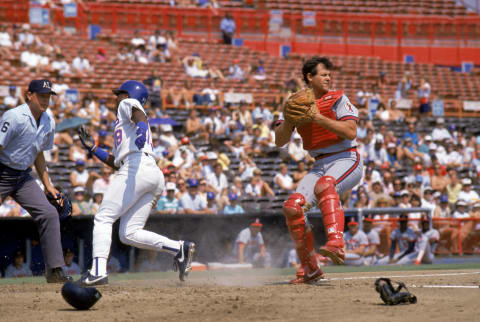
LA Angels all-time roster — Catcher: Bob Boone (1982-1988)
Bob Boone was a solid offensive catcher during his time with the Los Angeles Angels franchise, but he truly excelled behind the plate. Although on the wrong side of 30 during his time in California, Boone proved to be a decent hitter and a steady presence on the field.
Although he was no longer the hitter he had been during his time with the Phillies, Boone was able to provide some power and a stellar ability to put the bat on the ball. He may have only produced a .245/.297/.323 batting line, but he also struck out only 248 times in 3391 plate appearances with the Angels. Boone could protect the plate, and helped out in ways that did not appear in the box score.
Defensively, Boone was still a star. He won four Gold Gloves with the Angels, including one at age 39 (he’d win another one the following year at age 40 with the Royals). He led the American League in caught stealing percentage three times while in California, including a stellar 58% mark in his first season there in 1982. During those seven years, Boone saved an incredible 82 runs for the Angels.
The Angels all-time WAR leader amongst catchers, most of his value came from his defense. His DEF ranking on Fangraphs (a stat that combines fielding runs above average and positional adjustment) was 136.8, besting Gary Carter, the second highest-rated catcher, by 35.8.
The Los Angeles Angels, especially during Mike Scioscia’s time as manager, have preferred catchers with an excellent glove and decent offense. Bob Boone would have fit in perfectly.
Next: It's Wally's World
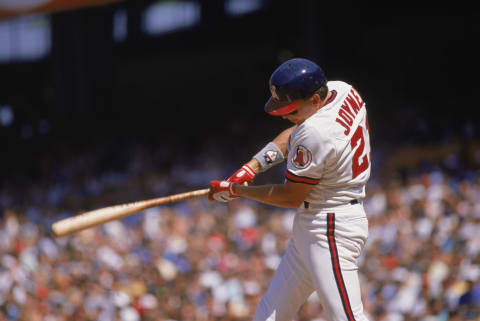
LA Angels all-time roster — First base: Wally Joyner (1986-1991)
When he first came up to the Los Angeles Angels as a ballyhooed prospect, the sky seemed to be the limit for Wally Joyner. He exploded onto the scene, making the All-Star Game and finishing eighth in the MVP vote in his rookie year. Joyner would then show improved power in his second year, slugging 34 home runs and posting a 137 OPS+. He appeared to be a burgeoning star in the making, a player that might be able to carry the Angels’ offense.
Even though he never became that superstar player, Joyner was a solid hitter for the Angels. He had a .286/.350/.450 batting line, hitting 117 home runs and 175 doubles in his seven seasons in California. Joyner also showed an excellent batting eye, with only 349 strikeouts against 336 walks in 3774 plate appearances.
Although he was not considered great defensively, Joyner was better than he was perceived to be. He saved the Angels 26 runs during his time at first, had above-average range and had a higher fielding percentage than the league average first baseman. Perhaps his lack of development on offense overshadowed his abilities with the glove, but Joyner was certainly better than he was given credit for.
After spending his first six years in California, Joyner came back to the Angels in 2001 to end his career. A part-time player, he had a .243/.304/.351 batting line, but still had that same ability to put the bat on the ball and draw a walk. He would go on to be a hitting instructor after his career ended, currently serving in that role for the Detroit Tigers.
Maybe wally Joyner was not the player that the Angels expected, but he still turned out to be a solid first baseman. In fact, he may have even been better than we remembered.
Next: An underrated second baseman
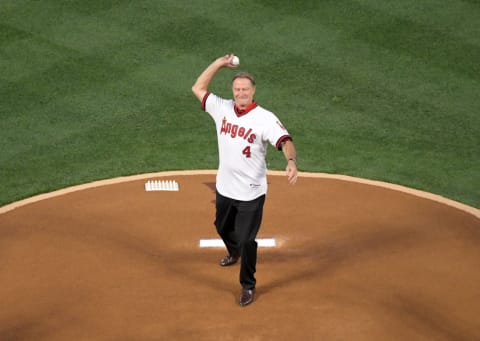
LA Angels all-time roster — Second Base: Bobby Grich (1977-1986)
A vastly underrated player in baseball history, Bobby Grich was not only a power-hitting second baseman, but also had a solid glove and the ability to draw a walk at a time when that skill was underappreciated.
During his time with the Angels, Grich made three All-Star Game, won a Silver Slugger award in 1981, when he tied for the American League lead in home runs, and finished 8th in the 1979 MVP race. In his best season in 1981, when he also led the league in OPS+ and slugging, Grich was left off the All-Star team and only finished 14th in the MVP award balloting.
During his decade in California, Grich proved to have plenty of pop in his bat. He hit double-digit home runs in seven consecutive years, an impressive feat for a time when middle infielders were just meant to be fast and catch the ball. He was also an on-base machine, showing a tremendous batting eye and routinely rating amongst the league leaders in walks.
That did not mean that Grich was a liability on defense. Although he never won a Gold Glove with the Angels after winning four in Baltimore, he still provided plenty of value defensively. Although he only was worth nine runs saved, he was an above-average second baseman who was able to make the plays needed. Age may have slowed him down, but he was still a solid player in the field.
Far and away the best second baseman in the history of the Los Angeles Angels, Bobby Grich was a borderline Hall of Famer whose career is only starting to get the recognition it deserves. His time on the Angels, meanwhile, places him firmly in the all time starting lineup.
Next: A key power bat
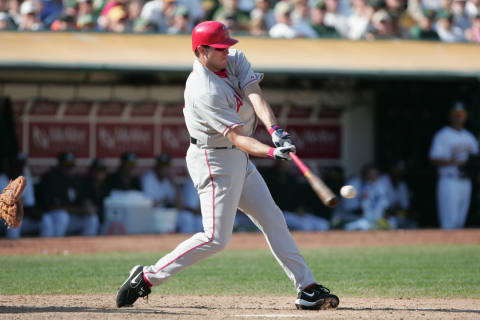
LA Angels all-time roster — Third Base: Troy Glaus (1998-2004)
An excellent young power hitter, Troy Glaus helped bring the Los Angeles Angels back to respectability, becoming a key part of their lineup.
Much like Joyner, Glaus appeared destined for stardom. In 2000, at age 23 and in his second full season in the league, he led the American League with 47 home runs and made his first All-Star Team. While his numbers slipped the following year, as Glaus lost 110 points in his OPS, he was still an All-Star and hit over 40 home runs for the second consecutive season.
That would prove to be the high water mark. Glaus would still be a solid third baseman, and hit 30 or more home runs three more times in his career, but he would never reach his potential. Derailed because of injuries, particularly to his feet, Glaus saw his career end at age 33 as he was never the same slugger as he was in his early days.
He was also more than just a slugger. While Glaus would never be confused for Brooks Robinson or Graig Nettles at third, he was a serviceable player who saved the Angels 13 runs in his seven years in California. Considering his power potential, the fact that he was able to provide league-average defense made him an asset in the field.
Glaus would continue to be plagued by injuries later in his career, and would be linked to PED use when it was reported that he had received several shipments of testosterone and nandrolone in 2003 and 2004. However, even with those allegations, Glaus would be a solid middle-of-the-order bat for the all-time Los Angeles Angels team.
Next: The Angels' first true star
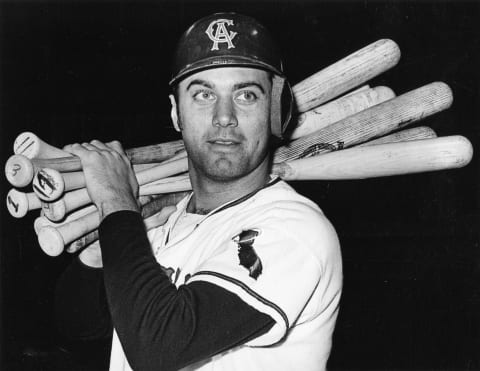
LA Angels all-time roster — Shortstop: Jim Fregosi (1961-1971)
These days, Jim Fregosi is remembered for his time as a manager and for being the player traded to the Mets for Nolan Ryan. However, he should also be remembered as the first true star for the Los Angeles Angels.
Selected by the Angels with the 35th selection in the Expansion Draft, Fregosi made his debut at age 19, and rapidly developed into a star. He made the All-Star Game in his second full season in 1964, starting a run where he would make six appearances in the game in seven years. Fregosi provided solid pop for a shortstop, hitting double-digit home runs five times, and solid speed, even leading the American League with 13 triples in 1968.
Defensively, Fregosi was equally valuable. He won a Gold Glove award in 1967, and was routinely among the league leaders in putouts, assists and double plays. During his time in California, he was worth 29 runs saved, helping solidify the middle of the Angels infield.
Fregosi even helped the Angels after he left. Following a difficult 1971 season, he was traded to the New York Mets in one of the most lopsided deals in baseball history, as he netted a package that included future Hall of Famer Nolan Ryan. For his part, Fregosi only spent a season and a half in New York before being sold to the Rangers.
One of the original stars with the Los Angeles Angels, Jim Fregosi had an impact on the franchise that extended over their first two decades of existence.
Next: Swimming upstream
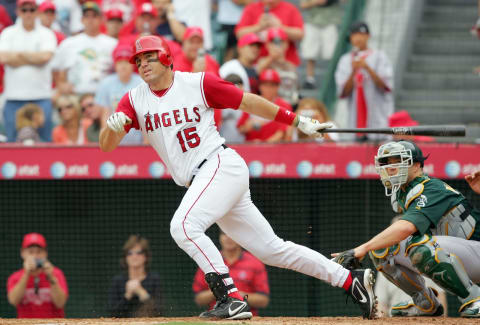
LA Angels all-time roster — Right Field: Tim Salmon (1992-2006)
Through what was essentially a decade of futility in the 1990s, Tim Salmon established himself as one of the best players on the Los Angeles Angels. He spent his entire career with the Halos, with his World Series ring in 2002 the ultimate reward for his dedication.
Salmon was a top prospect during his time in the minors, and carried that success over when reaching the Majors. He won the Rookie of the Year award in in 1993, producing a .283/.382/.536 batting line with 31 home runs and 35 doubles. Two years later, when he hit at a .330/.429/.594 rate with 35 home runs in his best season, he finished seventh in the MVP ballot and won his only Silver Slugger award.
Despite never making the All-Star Game, there was no denying what Salmon brought to the Angels when healthy. He was a cornerstone player, a middle-of-the-order bat who provided the Angels with excellent power until he was slowed by injuries. Yet, he was able to hold on and be a key part of the Angels’ run to the World Series.
Defensively, Salmon was an excellent offensive player. While he played in right field, he was decidedly below average with the glove, with a -139.9 DEF score. He cost the Angels a total of 38 runs in right before eventually being shifted to their designated hitter. Salmon did, however, have a solid enough arm, accumulating 100 career assists and turning 23 double plays.
Another player whose career did not turn out as expected due to injuries, Tim Salmon was still a key part of the Angels resurgence, developing into one of their stars in the 1990s. In fact, given the relative lack of accolades during his career, he may have been one of the more underrated players during his time.
Next: Already one of the Angels' all-time greats
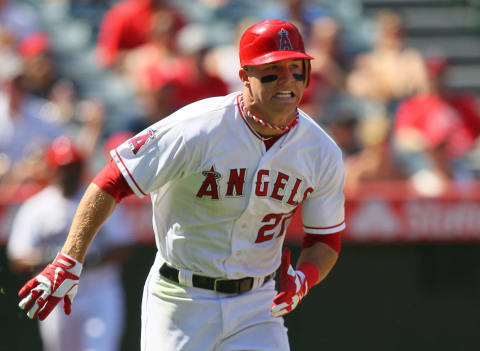
LA Angels all-time roster — Center Field: Mike Trout (2011-present)
In just about 10 years, Mike Trout already ranks third on the Los Angeles Angels all-time WAR list. He may already be the greatest Angel of all time.
Trout already has the hardware to make such a claim. At 29 years old, he has made eight All-Star Games, won a Rookie of the Year award and three MVP awards, and has eight Silver Slugger awards. He has yet to finish any worse than second in the MVP balloting in his first four full Major League seasons, a trend that may well continue this year.
Already a mainstay at the top of the Angels’ leaderboards, Trout is first in home runs, second in stolen bases and third in runs scored. He is the Angels all-time leader in slugging and on-base percentage. And, considering he is just entering his prime, he could get even better in the next few years.
On defense, Trout may not have a Gold Glove yet, but has generally been above average. He has 5 defensive runs saved above average in center, and has been just about average in left and right. Trout has displayed steady improvement in the field, claiming the leaderboards in the traditional categories while showing improvement in the various metrics.
Seemingly destined to be the greatest Angel of all-time, Mike Trout is the type of player that a team dreams of. Now, if only the Angels can take advantage of his prime and get him back to the postseason.
Next: Another key championship piece
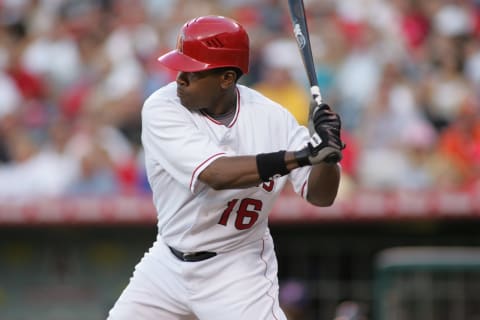
LA Angels all-time roster — Left Field: Garret Anderson (1994-2008)
While the Los Angeles Angels may have struggled in the 1990s, they were putting together the pieces to set up their excellent teams of the following decade. Garret Anderson was one of those key pieces.
Brought up to the Angels a couple of years after Tim Salmon, Anderson was another player who was overlooked during his career. He only made three All-Star Games, and appeared on the MVP ballot three times. He did win two Silver Slugger awards, but his performance was lost due to the inflated numbers of the Steroid Era.
However, that should not take away from the player that Anderson was. While he would never be confused for an on-base machine, he had a solid ability to make contact, striking out over 90 times only twice in his career. A .296/.327/.469 hitter with the Angels, Anderson also chipped in 272 home runs and 489 doubles, providing a steady presence in the middle of the Angels order.
He was also vastly underrated defensively. Anderson never won a Gold Glove, but he was worth 80 runs saved for the Angels, leading the league twice and finishing his career with the fourth-highest total in MLB history. He may not have had many chances in left comparatively, but he made the most of those he had, even making plays that most left fielders would not be able to conceive of.
A solid all-around player, Garret Anderson was a mainstay of the Angels lineup for most of his career. One of the best players in team history, Anderson could even make a case for being one of the best defensive left fielders that the game has ever seen.
Next: This Hulk didn't turn green
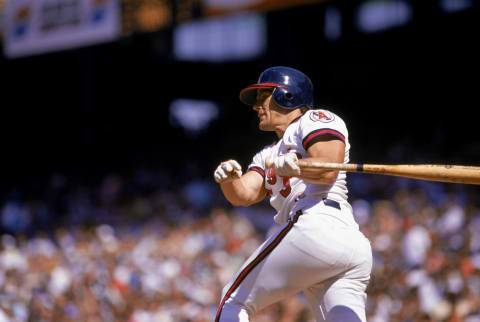
LA Angels all-time roster — Designated Hitter: Brian Downing (1978-1990)
Known for being one of the first players to focus on weightlifting to improve his ability, Brian Downing was a backup for most of his career until joining the Los Angeles Angels. There, he blossomed into a solid hitter, whose ability to get on base certainly attracted the Angels’ notice.
He was a throwback to the times when teams focused on having a leadoff hitter get on base, regardless of their foot speed. Prized for his ability to take a walk and make contact, Downing drew 866 walks in his 13 years with the Angels, striking out only 759 times. He even led the league with 106 free passes in 1987, helping set the table for the other hitters behind him.
Downing was also a solid slugger in his own right. In each of his full seasons in California, he had double-digit home runs, hitting 20 or more six times. He was a rarity in his time – a leadoff hitter with power who could draw a walk, yet lacked the speed that most teams coveted atop the lineup. Yet, he was a baseball player, something that few of those other, more traditional, leadoff hitters could actually say.
The Angels tried him in different capacities on the field before he settled in as their designated hitter. Originally a catcher, he started the 1978 All-Star Game behind the plate in his only appearance in the game. After a broken ankle ruined two seasons, he moved to left, putting up below average numbers before focusing on his ability to swing a bat.
Brian Downing was a pure hitter. It is unfortunate that it took until his trade to the Angels at 28 years old for a team to realize what they had in him.
Now, to the all-time Angels bench.
Next: A great stick behind the plate
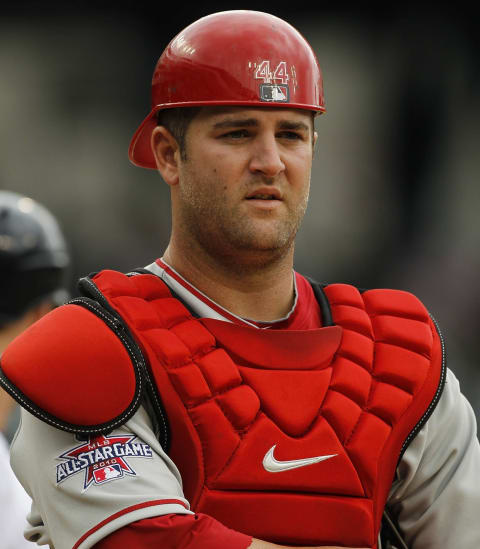
LA Angels all-time roster — Backup catcher: Mike Napoli (2006-2010)
Despite his numerous trips into Mike Scioscia’s doghouse due to perceived defensive shortcomings, Mike Napoli was one of the better catchers the Angels had, even if he was consistently removed from the lineup.
At a position where the Angels were typically lacking anything resembling offense, Napoli was quite the producer with the bat. He hit double-digit home runs in each of his five seasons in California, including getting over 20 three times. Eventually, his offense forced him into the lineup, as Scioscia had him split time at first base and behind the plate.
Defensively, Napoli was not nearly as bad as Scioscia thought. While he may not have had the strongest arm behind the plate, or make anyone forget about defensive catchers like Bob Boone, Napoli was about league average as a catcher. In fact, at least in regards to range factor, he was closer to being average there than he has been at first base in his career.
While Napoli would continue to show improvement with the glove, and his bat gave the Angels an offensive element they were otherwise lacking, he was eventually sent out of town, traded to the Blue Jays for Vernon Wells. As Napoli went on to be an All-Star and a solid first baseman/designated hitter, Wells was a complete bust in California. That’s one trade they would like to have back.
Mike Napoli was a solid player, and a better fielder than many wanted to give him credit for. As it would turn out, he was one of the best catchers, if not the best offensively, in Angels history.
Next: A stellar utility player
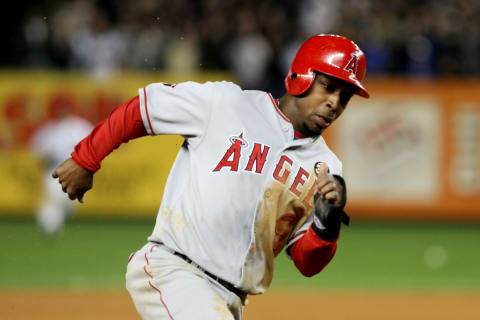
LA Angels all-time roster — Utility: Chone Figgins (2002-2009)
These days, Chone Figgins is remembered for being a complete disaster for the Seattle Mariners after signing as a free agent. However, during his time with the Los Angeles Angels, he was one of the best utility players in baseball.
Although he bounced around the field before eventually settling in at third, Figgins found himself in the lineup virtually every day. A solid leadoff hitter with great speed, Figgins led the American League with 101 walks in 2009 en route to a .298/.395/.393 batting line, making his only All-Star game and finishing tenth in the MVP ballot.
An excellent speedster in addition to his ability to get on base, Figgins had 30 or more stolen bases in six consecutive seasons with the Angels, leading the league with 62 steals in 2005. During those six seasons, Figgins did not finish worse than sixth in steals, establishing himself as one of the premier stolen base threats and leadoff men in the game.
On defense, Figgins saw time at third, second, short, center and left before he eventually settled in at what would be his permanent home at the hot corner. That would prove to be a smart decision, as he was below average elsewhere in the field, but saved 24 runs at third for the Angels. He may not have been the prototypical power hitter that one equates at third these days, but he certainly had the glove for the position.
Chone Figgins was a valued piece of the Angels, capable of playing virtually anywhere on the field before entrenching himself as their everyday third baseman. For utility purposes, he would be the perfect role player on the all-time Angels squad.
Next: The fourth outfielder
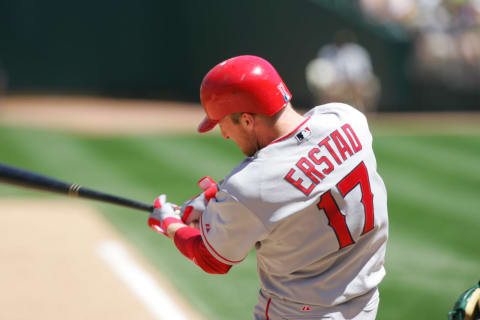
LA Angels all-time roster — Outfield: Darin Erstad (1996-2006)
Another underrated part of the Angels World Series team, Darin Erstad put together one of the better seasons in the 2000s, but barely received any recognition for it.
Recognized as a solid offensive player, Erstad had a career year in 2000. Making his second of two career All-Star Games, and winning the only Silver Slugger of his career, he produced a .355/.409/.541 batting line, hitting 25 home runs with 28 stolen bases and a league-leading 240 hits. Yet, he only finished in eighth in the MVP vote that year, his production overshadowed by the videogame numbers that were prevalent at the time.
Erstad, even though he flew under the radar, was a solid all-around player for the Angels. Even though he would never again approach those power numbers, he produced a .286/.341/.416 batting line with 117 homers and 170 stolen bases. He chipped in 279 doubles as well, the fourth-highest total in team history.
Defensively, Erstad was one of the best center fielders in the game. He saved 72 runs in center, and when pressed into action in left, was equally adept there, saving the Angels another 45 runs. Although he did not see much time in right, it is easy to imagine that the three-time Gold Glove winner would have handled that position with ease as well.
A solid all-around player, Darin Erstad was the key piece on defense in the Angels outfield during their resurgence, capable of covering virtually anywhere in the outfield.
Next: Another utility player

LA Angels all-time roster — Utility: Howie Kendrick (2006-2014)
Although he spent most of his time with the Los Angeles Angels at second base, Howie Kendrick has turned into a versatile player, and one who can be plugged into many different spots in the lineup.
In some ways, Kendrick was viewed as a disappointment with the Angels. He had produced stellar numbers in the minors, and while he was a solid Major League option, Kendrick never carried over that same production. he made one All-Star team, and only received MVP votes once, in his final year with the Angels in 2014.
Yet, that ignores what Kendrick was able to do. He was a solid power and speed threat in the middle of the infield, hitting double-digit homers four times and stealing ten or more bases six times. He would rarely draw walks, but he had the ability to put the bat on the ball and make solid contact. With his gap power and speed, he was able to hit quite a lot of doubles, never having fewer than 21 in a season.
A solid second baseman, Kendrick saved the Angels 27 runs during his nine seasons with the team. While he does not have the same level of ability at other positions, he has become a valuable asset around the diamond, capable of slotting in at left, third or even first base to give a player a day off.
One of the better players in the history of the Los Angeles Angels, Howie Kendrick ranks eighth all-time in WAR, ahead of such franchise stalwarts as Figgins, Glaus and Jim Edmonds. In fact, he may have been a lot better than he was remembered to be.
And now, on to the pitching staff.
Next: The kid became an ace
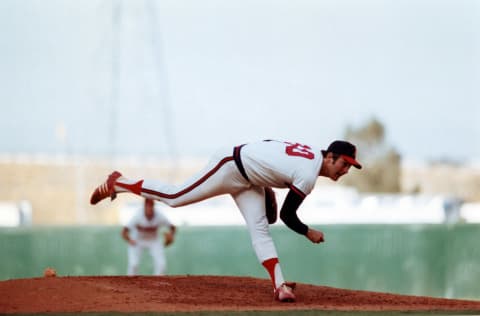
LA Angels all-time roster — Starting Pitcher: Nolan Ryan (1972-1979)
Nolan Ryan was an intriguing talent with a high octane fastball, but no real idea of where it was going when he was acquired from the New York Mets. When he joined the Angels, he became a star.
Ryan’s ascension to stardom began in 1972, as he made the All-Star Game for the first time in his career and led the American League in strikeouts. He also led the league in walks and wild pitches, but Ryan served notice that he was about to take his place amongst the best pitchers in the game. His fastball, and lack of command at times, made him an imposing figure on the mound, someone that could strike fear in the opposition.
He truly broke out the following year. Ryan pitched the first two of his seven career no-hitters, struck out a Major League record 383 batters, won 20 games for the first time in his career, and finished second in the Cy Young vote. The Angels had their ace, and Ryan had taken that next step to superstardom.
During his time with the Angels, Ryan posted a 138-121 record with a 3.07 ERA and a 1.294 WHiP, striking out 2416 batters in 2181.1 innings of work. He helped bring the Angels to their first playoff appearance in 1979, where they lost to the Baltimore Orioles in four games during the ALCS. Ryan, by becoming that star pitcher, helped change the fate of the franchise, helping them to contend in the latter part of the 1970s.
The first ace for the Los Angeles Angels, and one of the more dominating pitchers in MLB history, Nolan Ryan blossomed into a star in California. That is one deal the Mets wish they could have back.
Next: A solid innings eater
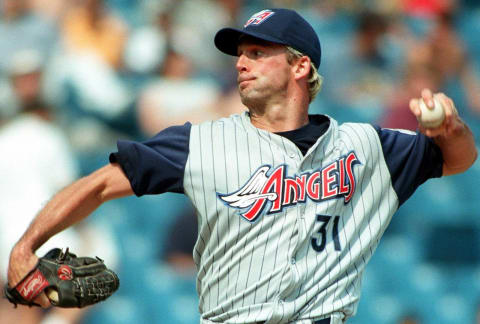
LA Angels all-time roster — Starting Pitcher: Chuck Finley (1986-1999)
Chuck Finley may not have been a star, but he was a solid pitcher in the middle of the rotation for the Angels, taking the ball every fifth day and churning out inning after inning of worry-free ball.
There was a time when Finley appeared as though he would become a star. In a two-year span in 1989 and 1990, Finley made the All-Star team both years, posting a 34-18 record with a 2.48 ERA and a 1.249 WHiP. He struck out almost seven batters per nine innings, and while his walk rate was a bit high, the hope was that he could develop into a top of the rotation starter.
Instead, Finley was unable to build off of that early success. He settled in as a middle of the rotation innings eater, pitching 200 innings or more virtually every year from 1990 through 2000, missing the mark in 1994 due to the strike and in 1997 due to injury. During the strike year, he still led the league with 183.1 innings in 25 starts, and would have easily surpassed 200 innings he there been a full slate of games.
With the Angels, Finley proved to be a steady, if unspectacular, pitcher. He posted a 165-140 record with a 3.72 ERA and a 1.369 WHiP, striking out 2151 batters in 2675 innings. His biggest issue during his career was his command, as Finley walked nearly four batters per nine innings. Considering that he allowed fewer than a hit per inning, if Finley had been able to improve his command, he may have reached the stardom he appeared destined for.
Every team needs a pitcher like Chuck Finley, one that can go out there, take the ball every fifth day, and provide six or seven solid innings virtually every time out. And yet, for as good as he was, it almost felt as though his career was a bit disappointing.
Next: Somehow still getting by
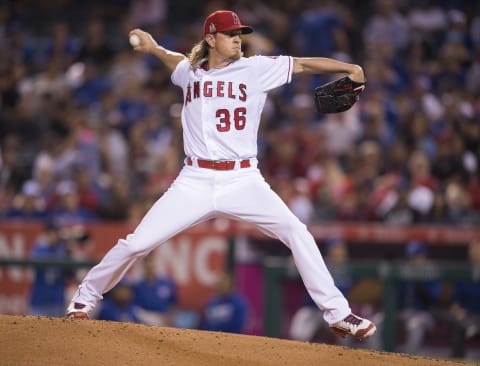
LA Angels all-time roster — Starting pitcher: Jered Weaver (2006-2016)
Near the end of his career it was easy to look at Jered Weaver struggle to hit 80 mph with his fastball and wonder how he is still in the majors. Yet, not that long ago, he was one of the better pitchers in baseball and an ace for the Angels.
In his early days, Weaver was one of the best pitchers in the game. That dominance manifested early, as he posted an 11-2 record with a 2.56 ERA in 19 starts in his rookie year. He made three All-Star Games, led the American League in wins twice, won the 2010 strikeout crown with 233 punchouts, and has fired two no-hitters, including a combined no-hitter that resulted in a loss.
Then the injuries began. He fractured his elbow on April 7, 2013, as he dodged a line drive up the middle, causing him to miss almost two months of the season. He then had back issues the following year, but still led the league in wins. However, since that point, Weaver’s velocity had dropped sharply, to the point where he averages 83.72 mph with his fastball this season, a 4 mph loss in two years.
Yet, it is for those early days that Weaver would make the all-time Los Angeles Angels’ rotation, back when he was a phenom and looked like a future star.
Next: The young fireballer
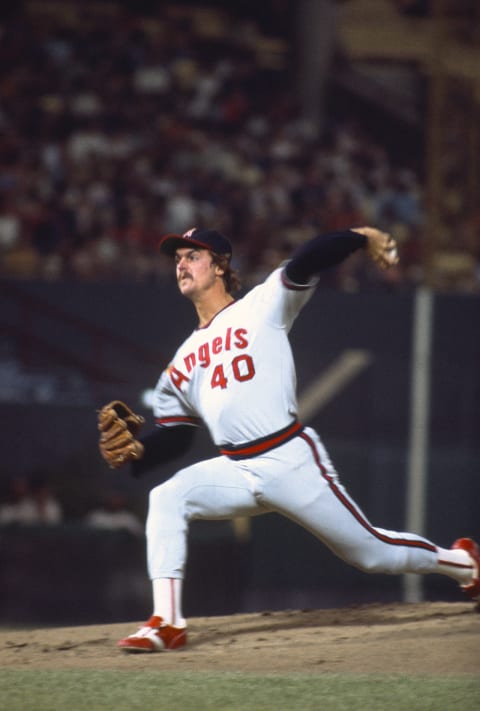
LA Angels all-time roster — Starting Pitcher: Frank Tanana (1973-1980)
If Weaver needed any further inspiration in his attempt to transform from a strikeout artist to a finesse pitcher, he would not need to look any further than former Angels pitcher Frank Tanana.
When he first reached the Majors at 19 years of age, Tanana looked like he would pair with Nolan Ryan to give the Angels one of the best duos to front a starting rotation. At first, he did just that, making three All-Star Games and leading the league with 269 strikeouts in 1975. Unlike Ryan, Tanana had the command to go along with his blazing fastball, making him a truly formidable starter.
Then, he injured his shoulder, losing his 100 mph fastball in the process. He spent his final season with the Angels looking to refine his pitching, beginning the process of becoming a junkballer and relying upon his curve and offspeed pitches to fool opposing batters into weak contact. It was quite the departure from the pitcher that Tanana was, but he still remained effective into his late 30’s.
Overall with the Angels, Tanana posted a 102-78 record with a 3.02 ERA and a 1.166 WHiP, striking out 1233 batters against 422 walks in 1615.1 innings. He was so effective and was just as dominant as Ryan that he was part of the phrase” Tanana and Ryan and two days of cryin,” referring to the Angels pitching staff in the 1970s.
Frank Tanana truly dominated before his injury issues set in. Had he not hurt his arm, one has to wonder what his career arc would have been.
Next: A great gloveman on the mound
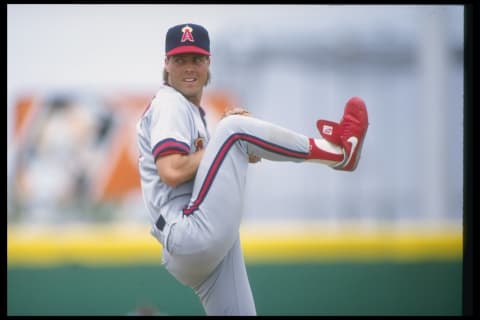
LA Angels all-time roster — Starting Pitcher: Mark Langston (1990-1997)
Once one of the premier strikeout pitchers in baseball, Mark Langston struggled with elbow injuries during his time with the Los Angeles Angels. He still managed to be effective, and end up as one of the better pitchers that the Angels have had in franchise history.
Signed as a free agent after spending most of the 1989 season with the Montreal Expos, Langston was expected to pair with Chuck Finley to give the Angels that formidable front of the rotation duo they had been lacking. Instead, he struggled in his first season in California, posting a 10-17 record with a 4.40 ERA and a 1.430 WHiP as he attempted to adjust to his new surroundings.
However, in the next three seasons, Langston was the pitcher that the Angels envisioned. He made the All-Star Game each year, and began a stretch where he won five consecutive Gold Glove awards. Then, after pitching 256.1 innings in 1993, he began to develop the elbow issues that would hinder him for the rest of his career.
With the Angels, Langston posted an 88-72 record with a 3.97 ERA and a 1.309 WHiP, striking out 1112 batters. While his numbers were close to league average, his three-year run before his elbow troubles began were worthy of the contract that he had signed, as it appeared as though Langston would be the ace that the Angels had been seeking for years.
Mark Langston may not have been the starter that the Angels envisioned throughout his tenure in California, but he still pitched well before his elbow began to give out. Otherwise, they may well have gotten that top-of-the-rotation starter they needed.
And now, on to the bullpen.
Next: A postseason revelation
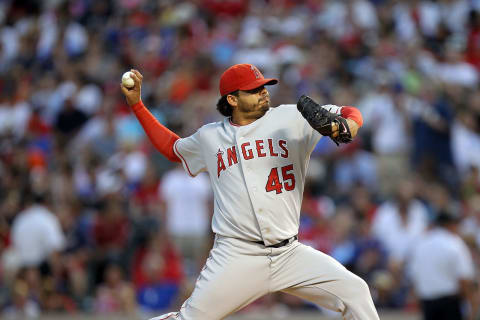
LA Angels all-time roster — Closer: Francisco Rodriguez (2002-2008)
Francisco Rodriguez may not be the all times saves leader in Los Angeles Angels history, but he was certainly the most dominant.
Rodriguez burst on to the national stage during the Angels’ run to the World Series in 2002. A 20-year-old phenom, he was a September callup, but dominated during his brief run, striking out 13 batters in 5.2 innings of work. Added to the postseason roster as an injury replacement, he continued to dominate, striking out 28 batters in 17.2 innings while posting a 5-1 record.
After spending most of the next two seasons as the Angels setup man, he became the full-time closer in 2005. That began an impressive run of success, where Rodriguez would save 40 or more games in each of his last four years in California, leading the league three times.
In his final year with the Angels, Rodriguez would make history. He recorded 62 saves, shattering the previous record of 57 set by Bobby Thigpen. Unfortunately, his success did not translate to the postseason this time, as Rodriguez struggled against the Red Sox in the postseason, going 0-1 with a 7.71 ERA and a 3.000 WHiP as the Angels lost the ALDS in four games.
Despite bouncing between the setup and closer roles after leaving the Angels, Francisco Rodriguez has still been a solid reliever, and can still dominate on occasion. Yet, nothing will come close to the performance he had as a member of the Angels.
Next: The saves leader

LA Angels all-time roster — Setup man: Troy Percival (1995-2004)
Originally drafted as a catcher, Troy Percival struggled with the bat, posting a .203/.370/.203 batting line in the Northwest League. When coaches noticed that his throws to the mound were often harder then the pitches he caught, Percival was made a pitcher and the rest was history.
Originally possessing a fastball that would touch 100 MPH, Percival originally began his career with the Angels as a setup man before taking over the closer role the following year. That season, he made the first of his four All-Star Games, and became the fourth Angels pitcher to strike out 100 batters in a season without starting a game.
He continued his effectiveness throughout the rest of the 1990s and into the early part of the 2000s, making four All-Star Games and saving 30 or more games eight times in nine years. During that season where he failed to reach the 30 save plateau, Percival still managed to notch 27 saves. He may never have led the league, but Percival placed in the top five in saves seven times and currently ranks 11th all time.
Percival lost his excellent fastball later in his career due to a degenerative hip condition, but remained relatively effective, despite a severe drop in strikeouts. Leaving the Angels following the 2004 season, he ended his tenure with a 2.99 ERA and a 1.101 WHiP, notching 316 saves and striking out 680 batters in 586.2 innings.
Troy Percival may not have made the conversion to the mound until he was already in pro ball, but he certainly made up for lost time, becoming one of the best relievers in the history of the Los Angeles Angels.
Next: If only he could stay healthy
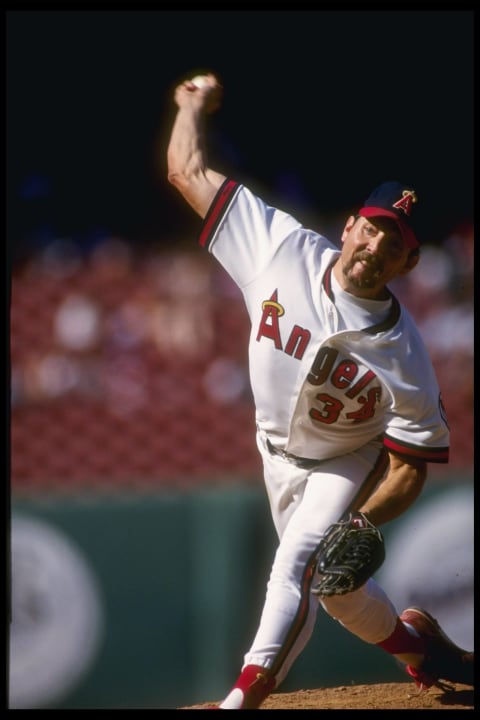
LA Angels all-time roster — Reliever: Bryan Harvey (1987-1992
The Los Angeles Angels had a nice run of dominant closers during their time, homegrown talents that were capable of dominating during the ninth inning. Bryan Harvey was the start of that impressive array of talent.
Signed as an amateur free agent in 1984, Harvey made his Major League debut only three years later, appearing in three games with the Angels. The following year, Harvey took over as the Angels closer, a role that he would not relinquish until he suffered an elbow injury in 1992.
Between that time, Harvey established himself as a dominant closer. Armed with an excellent fastball and devastating forkball, he made the All-Star team in 1991, a year where he posted a 1.60 ERA and a 0.864 WHiP, notching a league-leading 46 saves and striking out 101 batters in 78.2 innings.
Those elbow injuries would end his time with the Angels. After posting a 2.49 ERA with 126 saves in his six years in California, the Angels left him unprotected in the 1993 expansion draft. Selected by the Marlins, he would go on to have one more stellar season before his elbow began to have issues once more, forcing his retirement at 32 years of age.
Had his elbow held together, Bryan Harvey may have been one of the more dominant closers of the 1990s. Instead, he will be remembered as the homegrown talent that started an impressive run of closers for the Angels.
Next: A stellar setup man
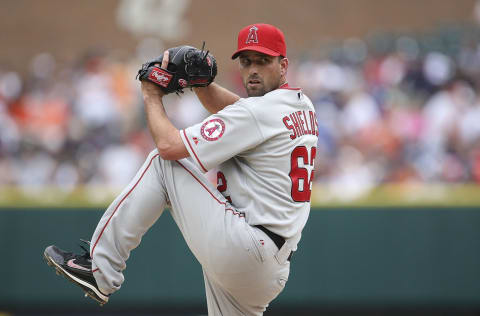
LA Angels all-time roster — Reliever: Scot Shields (2001-2010)
At the beginning of his career, it felt as though the Los Angeles Angels did not know what they had in Scot Shields. It turned out that what they had was a solid middle reliever who ranks third in Angels history in WAR for relievers.
After bouncing between the setup, long relief and spot starter roles, Shields finally found a home as the Angels setup man in 2004. He notched 17 holds that year, and became one of the sixth relievers in Angels history to record 100 strikeouts without starting a game. The following year, Shields would record 30 or more holds for the next four years, establishing himself as one of the best eighth-inning arms in the game.
Shields spent his entire 10year career with the Angels, appearing in 491 games with 15 starts, 13 of which came in 2003. He posted a 3.18 ERA and a 1.244 WHiP, striking out 631 batters in 697 innings pitched while recording 155 holds.
He was at his best with runners on base. Of the 193 batters he inherited, only 57 came around to score. As he was routinely used in high leverage situations for the Angels, that ability to strand baserunners proved to be vitally important.
Setup men have typically been the anonymous throughout baseball history, receiving attention only when they implode. For Scot Shields, that attention was something he managed to escape more often than not.
Next: A tragic end
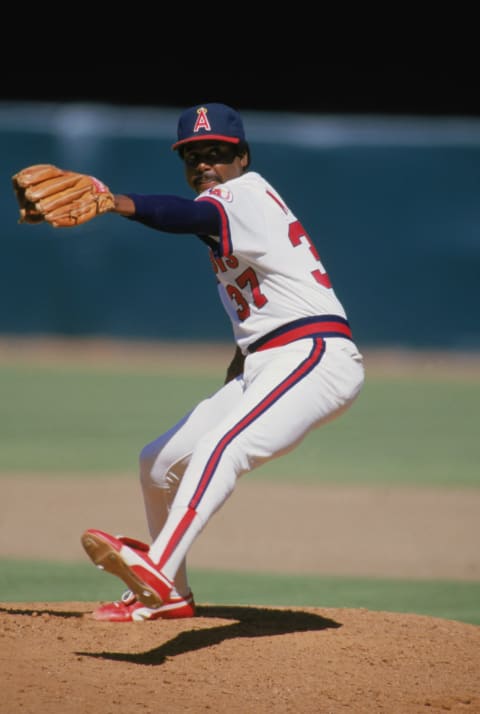
LA Angels all-time roster — Reliever: Donnie Moore (1985-1988)
Donnie Moore did not become a full-time closer until joining the Los Angeles Angels as a free agent compensatory pick prior to the 1985 season. However, for a two-year span, he was one of the best closers in the game.
During his first two seasons with the Angels, Moore was a game-changer. He made the All-Star Game in 1985, a year where he would finish seventh in the Cy Young vote, but sixth in the MVP balloting. The following year, his performance helped put the Angels in the postseason. Overall during that two-year run, he posted a 2.36 ERA and a 1.104 WHiP, notching 52 saves.
Then came disaster. With the Angels about to make the World Series, Moore gave up a game-winning home run to Dave Henderson, extending a series that the Red Sox would win in seven games. That home run would haunt Moore for the rest of his days, as he was never the same pitcher afterward, as he lost his confidence and was eventually released by the team.
Unfortunately, that home run would play a part in the end of his life. Battling depression, Moore shot his estranged wife three times following an argument. As their daughters rushed their mother to the hospital, Moore turned the gun on himself in front of their son, killing himself.
One of a handful to players to commit suicide due to being haunted by the game, it was a tragic end for a pitcher who was a key part of the Angels resurgence in the 1980s. Perhaps if depression was better understood in those days, Moore would have been able to get past that one moment.
Next: Another effective middle reliever
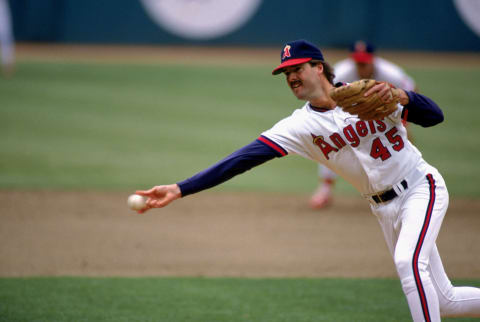
LA Angels all-time roster — Reliever: Mark Eichhorn (1990-1992, 1996)
At one time, Mark Eichhorn had a solid fastball and a regular throwing motion. However, a severe shoulder injury cost him that velocity, and led to his becoming a submarine pitcher.
That change paid immediate dividends, as his mediocre offerings were suddenly effective. He returned to the Majors after four years in the minors, and after spending time with the Blue Jays and the Braves, signed with the Angels as a free agent prior to the 1990 season.
In his first stint with the Angels, Eichhorn was one of the better middle relievers in the game. He appeared in 195 games in his two and a half years, posting a 2.73 ERA and a 1.213 WHiP, striking out 179 batters against 66 walks in 254 innings. He even occasionally served in the closer role in 1990, recording 13 saves as he shared time with Bryan Harvey.
He returned for one last stint with the Angels in 1996, a year after missing the 1995 campaign with injuries. He struggled that year, posting a 5.06 ERA and a 1.549 WHiP before succumbing to injury once again. Although he attempted to make a comeback twice, he never returned to the Majors again.
One of a handful of submariners that were in the Majors in the late 1980s, Mark Eichhorn was a solid pitcher who, if he had stayed healthy, may have had a more prominent place in the all-time Angels bullpen.
Next: The long man
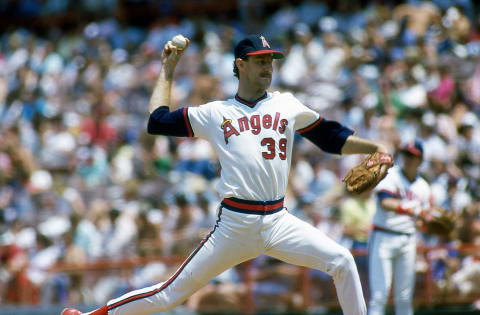
LA Angels all-time roster — Long reliever/spot starter: Mike Witt (1981-1990)
Mike Witt was another pitcher that the Los Angeles Angels were not quite sure of what they had in him for the first few years of his Major League career. In the end, he turned out to be a staff ace for a four-year span in the middle of the 1980s.
From 1984 through 1987, Witt led the Angels in wins, strikeouts, innings pitched and complete games in every season. He made two All-Star Games, and finished third in the 1986 Cy Young balloting. Witt also pitched the eleventh perfect game in MLB history, a 1-0 victory over the Seattle Mariners on the final day of the season.
That would not be the only no-hitter that Witt would be a part of. On April 11, 1990, he pitched the final two innings of a combined no-hitter with Mark Langston as the Angels defeated the Seattle Mariners. That would also be his last hurrah in an Angels uniform, as he was traded exactly a month later to the New York Yankees for Dave Winfield.
A pitcher that appeared to be on the verge of becoming a star until he suddenly lost his stuff during the 1987 season, Mike Witt served in a variety of roles with the Angels, filling each admirably.